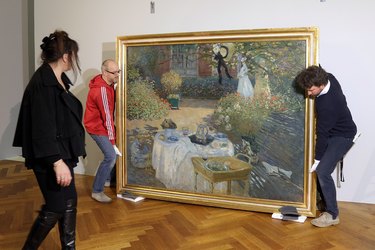
Claude Monet fathered the Impressionistic movement in late 19th century France with his abstract rendering of boaters on a river, titled "Impression, soleil levant." Monet painted consistently from 1874 until his death in 1926, and was most noted for his use of color and depictions of nature. His paintings often featured the same subject at different times of day and ultimately inspired a devoted class of fellow artists and imitators.
Impressionism
Video of the Day
The primary characteristic of Monet's work is his commitment to Impressionism and its basic characteristics, such as a focus on texture, light and brushstroke. Monet's focus changed from the subject -- such as a boat, landscape or person -- to the way that paint works on a canvas. Monet's art seeks to capture what the eye sees and the dynamic change of landscape depending on perspective and light. This commitment to Impressionism originally began as a way to free himself from the rigid constraints of the Salon de Paris, but eventually survived as a signature style that characterized his lifelong body of work.
Video of the Day
Nature
Monet's work primarily focuses on scenes in nature. Even in his early work, which featured human forms, the natural world received as much attention as the human figures. His most famous paintings, such as his haystack series and water lilies, are exclusively depictions of nature. Monet also had a lifelong interest in water, which he painted in all its forms, from turbulent rivers to the placid surface of his own lily pond.
Use of Color
Monet's paintings are distinctive in that he did not use the traditional chiaroscuro method, which creates a three-dimensional effect using shadow and light. Instead, Monet used unbroken blocks of color in unexpected ways to create vibrant, but flat landscapes. For Monet and other impressionists, color was not intrinsic to an object, but instead determined by the quality of light thrown on it. Monet also avoided distinctive lines in his painting, instead using dots and patches of color to indicate forms.
Repeating images
Monet is also well-known for his repeated paintings of the same object at different times of day, reflecting the changes of color and light. One of his best-known series is of haystacks in a field, painted throughout a day and over several days in different qualities of light. Monet also painted series' of poplar trees and the Rouen Cathedral. Toward the end of his life, Monet devoted his time completely to painting his own lily pond throughout the year.